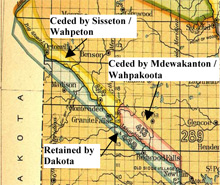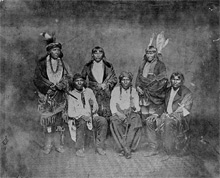1858 Land Cession Treaties with the Dakota
Signed June 19, 1858 in Washington, D. C.
Treaty wih the Sioux (Mdewakanton / Wahpakoota)
Treaty with the Sioux (Sisseton / Wahpeton)
In 1851, treaty commissioners Ramsey and Lea had described the last remaining Dakota land base as:
"sufficiently remote to guarantee the Indians against any pressure on the part of the white population for many years to come.”
And yet, land speculators (including Henry Sibley, as an agent for Pierre Chouteau) immediately began purchasing newly-ceded territory adjacent to the reservation. Although millions of acres in southern Minnesota had recently become available to white settlers, the narrow strip along the Minnesota River where all Dakota lived became a focal point for white migration.
Another factor in the economic development of the region that must have had an impact on the Dakota reservation was the burgeoning of railroads in Minnesota during the 1850s. Between 1854 and Statehood in 1858, twenty seven railroads were incorporated in Minnesota Territory – most of them speculative ventures that never laid track. But one of the land grant railroads co-owned by Territorial Governor Alexander Ramsey planned to pass near the Dakota reservation. Because railroad companies made their money selling land for town sites, the presence of an increasingly beleaguered Dakota nation in control of the Minnesota River front would have been a contentious issue.
One month after Minnesota became a State, Dakota people were taken to Washington to sign away the northern half of their holdings along the Minnesota River, in acknowledgement that white settlers had encroached on the land and planned to stay. The ceded land was to be sold to settlers, the proceeds going to the Dakota (though up to $140,000 could be used to pay the Dakota people's’ “just debts”). The remaining reservation was to be allotted to individual Dakota families, who were to subsist on annuity payments and farming.
After the Dakota War of 1862, the U.S. abrogated all of its treaties with the Dakota, seized the remaining 10-mile wide strip, and exiled them from the State. Not all of the Dakota had participated in the War, however, and in 1863 a treaty with non-combatant Dakota created the Sisseton reservation in present-day South Dakota. Beginning with Prairie Island in the 1880’s, Dakota lands were eventually restored in present-day Minnesota, with additional new tribal governments created in the Indian Reorganization Act of 1934.











